Stalking the wild model 1857 12-pound light gun-howitzer
14 September 2008
I drove through the fog to Sharpsburg yesterday, much earlier than is usual for me to be up on a Saturday. Arrived too early for the ANB Visitor’s Center to be open, in fact, but in time to catch Mr. Mumma cutting blossoms to place inside. Ranger Mannie was out early, too.
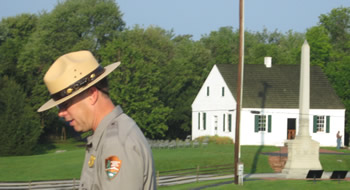
Ranger Keith at the NY Monument
I joined the surprisingly large group of about 25 who were led by Ranger Keith Snyder on the first of the special-subject hikes of the weekend: The Opening Guns.
Keith discussed the technology and application of artillery at Antietam, the personalities of some of the gunners, and led us on a hike of maybe a mile and a half from the VC out around the Cornfield and back, taking in some prominent gun positions and seeing first hand the subtlety of the terrain that is so critical to understanding the battle.
As it was in 1862, the corn in Miller’s famous field was greater than head high.
We were treated to an illustration of how close and terrible was the conflict between artillery and infantry at the location of Campbell’s (Battery B of the 4th US Artillery), just across the Hagerstown Pike from the Cornfield. We stood near where Hood’s Texans had been, face to face with the gun marking the position of Campbell’s six Napoleons.
Altogether, a most excellent way to spend a couple of hours on the field.
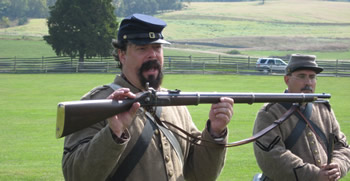
Infantry, Enfield 3-band rifle-musket
On returning to the VC, I replenished myself and caught a short, informative briefing on rifle tactics and procedures from butternut-clad reenactors Jim and Rob. I now have a greater appreciation for the relative importance of close-order tactics and mass fire over marksmanship at Sharpsburg. Thanks fellas.

Infantry, firing
I enjoyed also the demonstration of loading procedures and of “fire by file” and “fire at will” after a couple more infantrymen joined the fray.
Then it was across the VC plateau to the New York Monument to see the artillery live-fire.
As has been the case so often in the past, this one was led by the popular Ranger Al Preston of the South Mountain park with a pair of his bronze Model 1857 12-pounder light gun howitzers (say it 3 times fast). Word on the street is that Ranger Al is off to a job elsewhere in the Maryland Park system soon. Best wishes to him, and I hope his successor continues to bring the guns to Antietam.
I also saw and said hello to Rangers Brian Baracz and John Hoptak (happy birthday!) between rounds. Both were busy with tours all weekend, I gather, but were grinning like kids everytime I saw them.

St. Paul’s, Sharpsburg (church website)
After a quick stop for lunch provisions at the Battlefield Market, I drove into town for the Sharpsburg Heritage festival. I checked in first at the SHAF tent, then walked with Harry Smeltzer and Tom Clemens to their lectures at St. Paul’s. Their talks – Tom with a concise overview of the Shepherdstown battle, and Harry with his cool Threads talk – were very nicely done, both, but too few people were in town to enjoy them. Perhaps it’s just a quiet year.
More food after, at Captain Bender’s, then off home for a nap.
Another great day at Sharpsburg.
_____________
I’ve since found a little tidbit about the church that will require further research. Like I need more things on the list …
One of the attendees at Tom’s lecture was wondering why St. Paul’s Episcopal, originally built in 1819, had been re-built in 1871. According to the website history page:
During the battle of Antietam, September 17-18, 1862, the church was used as a hospital by the Confederate army. Many succumbed to their wounds in its precincts … The church was badly damaged in the fighting and had to be abandoned as a place of worship.
The Rev. Henry Edwards, St. Paul's ninth rector, raised funds to rebuild the church. The stones of the old church were [used] as well as the original bell… and building was completed in 1874.
Then I saw this:
Over the entrance there is a large circular window, or oculus, given in memory of Civil War Captain Fanning C. Tucker who died from wounds sustained at Antietam.
You know I had to look into the Captain.
According to the Soldiers and Sailors database, he was in Company H, 103rd New York Volunteer Infantry, entering service as a Lieutenant and leaving a Captain.
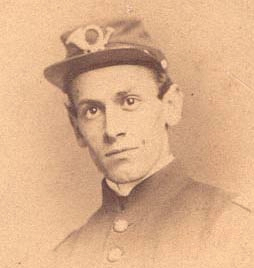
F.C. Tucker
Captain Tucker and the 103rd New York crossed the Antietam at Snavely’s Ford about 1pm on 17 September 1862, and suffered significantly in combat afterward.
Kraig McNutt has posted this fine CDV of Tucker on his Civil War Gazette site, identifying him as being in Company D and showing him mustering out 4 November 1862. I’ll need to look a little harder to get this all straight.
2024 update: a new bio page for Captain Tucker on Antietam on the Web.
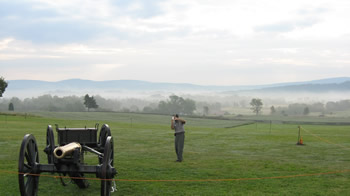

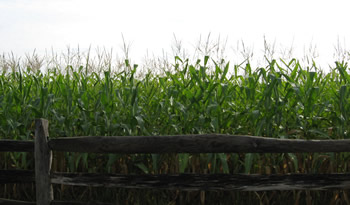
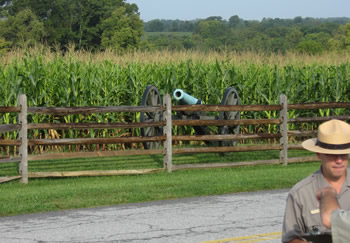
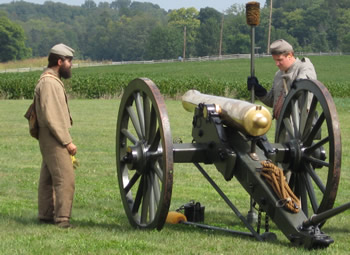

September 15th, 2008 at 9:09 pm
Brian,
Great follow-up on the church, thank you. It was great to see you there, and we’ll hope for good weather this weekend. And next year’s festival too.
September 23rd, 2008 at 9:31 am
Good post, Brian. I’d planned to attend the day’s activities but family business kept me away. Must have been a great day at the park!
June 5th, 2018 at 9:15 pm
Note: Fanning C. Tucker (1837-1878) is not listed among the casualties at Antietam, but could have been one. He survived the War, but died relatively young, at age 40, about 12 years after he was discharged, so it’s possible from lingering effects of a wound. He’s buried in Green-Wood Cemetery, Brooklyn.
March 6th, 2024 at 8:01 am
I’m the St. Paul’s “historian” and this is my first knowledge of our Chi-Rho window.
Here’s what’s most interesting. Fanning is the SECOND from 9 Corp remembered in a window. The other is Robert H. Ives, Jr.
Here’s the kicker…the lads of 103rd donated the Ives window.
Can anyone shed light on any of this. Specifically, why would a unit from far away NY focus on St. Paul’s. Our church was a hospital; maybe that’s the key.
March 6th, 2024 at 1:37 pm
Hi Linda, thanks for the comment!
I did not know Ives had a window in St. Paul’s: he died after being wounded at Antietam, but was not treated in the Church.
As a staff officer to General Rodman, their Division commander, Ives may have had friends in the 103rd New York Infantry and/or have been with or near them at the time of his wounding at Antietam – but I don’t have any specifics on that.
There’s no direct connection between Tucker and St. Paul’s that I’ve found, either. He was probably wounded at Antietam, but I have no information about if/where he was treated.
There is a version of the Chi-Rho symbol on Tucker’s tomb in Green-Wood Cemetery in Brooklyn. An indication of like-thinking, at least.
I did a check in John H Nelson’s As Grain Falls Before the Reaper: The Federal Hospital Sites and Identified Federal Casualties at Antietam (2004), and found only one individual soldier listed as a patient at St. Pauls – he was Private John L Taylor, 20th Maine Infantry, wounded at Boteler’s Ford on 20 September 1862. Private Alexander Simmerall, 155th Pennsylvania Infantry, with a non-combat complaint, may also have been there briefly, before being moved to the German Reformed Church.
In his discussion about St Paul’s, Mr Nelson notes that
I hope another reader will come upon your question and weigh-in.
March 7th, 2024 at 12:27 pm
The “Methodist Episcopal (M.E.) Church” was the ‘negro church’, known in our time as Tolson’s Chapel. It sits in view of Hill’s arrival.
“Protestant Episcopalian” was St. Paul’s denominational designation at the time.
Regarding the 20th Maine, a local historian has written that Joshua Chamberlain interceded on behalf of the [secessionist] rector John Adams when Adams was accused of allowing the Rebs into the church for use as a hospital.